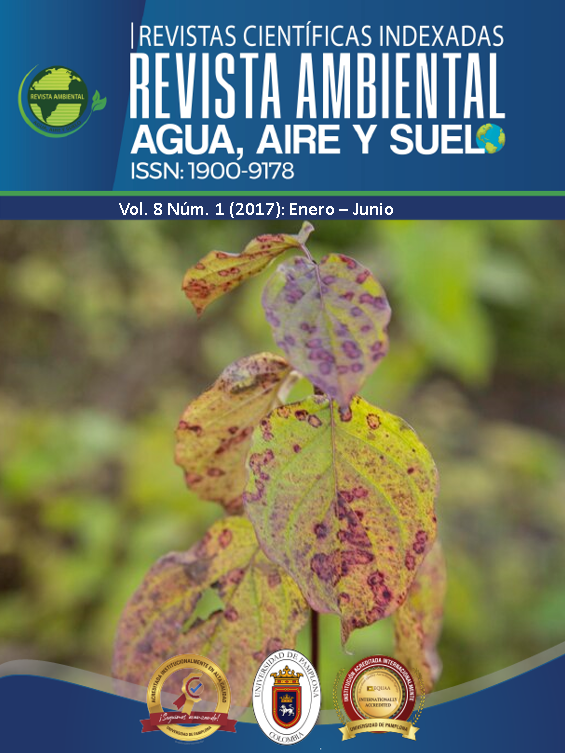Paleoclimatic and paleoenvironmental reconstruction of the territories of the Araucano floodplain based on the analysis of recent sediments, Arauca Department
DOI:
https://doi.org/10.24054/aaas.v8i1.2056Keywords:
Paleoclimas, correlación, estratigrafía, datosAbstract
In the areas influenced by the Arauca Floodplains, the different processes of sedimentation, deposition, and paleoclimates in the sector are reconstructed, allowing the creation of a model of the history and evolution of the territory over at least the last stages of the Late Pleistocene and throughout the Holocene. The sedimentological characterization and stratigraphic correlation of the area allow for a direct relationship with periods of system evolution where the area was partially flooded, as well as dry periods where the sediment types were of aeolian origin.
The morphology observed in the territories, particularly those linked to the Casanare and Arauca rivers, includes landforms such as levees, floodplains, and lateral barriers, while the main sedimentary contributions from the fluvial systems come from drainage channels. The sediments originate from primary source areas in the geological formations of the eastern flank of the Eastern Cordillera. The wind regime responsible for their formation had a preferential East–West direction, which, combined with the sand sources from large rivers located in the eastern part of the area, facilitated the formation of significant aeolian deposits. Finally, the current geomorphological units are used as a reference for reconstructing the ancient systems and their associated climatic conditions.
Downloads
References
Acosta, C. E. (1960). Estratigrafía de García Rovira. Boletín de Geología, Universidad Industrial de Santander, (5), 33–40.
Bayona, G., Cortés, M., Jaramillo, C., Ojeda, G., Aristizábal, J. J. A., & Reyes-Harker. (2008). An integrated analysis of an orogensedimentary basin pair: Latest Cretaceous-Cenozoic evolution of the linked Eastern Cordillera orogen and the Llanos foreland basin of Colombia. Geological Society of America Bulletin, 120(9–10), 1171–1197. https://doi.org/10.1130/B26222.1 (si tienes DOI, si no, se omite)
Bayona, G., & Thomas, W. A. (2003). Distinguishing fault reactivation from flexural deformation in the distal stratigraphy of the peripheral Blountian foreland basin. Basin Research, 15, 503–526. https://doi.org/10.1046/j.1365-2117.2003.00214.x (si aplica)
Beltrán, A. (2009). Caracterización de los patrones de fracturamiento en el área del Sinclinorio de Medina y la Falla de Guaicaramo, Piedemonte Llanero de los Andes Colombianos. Implicaciones en la exploración y producción de hidrocarburos en depósitos del Terciario [Tesis de maestría, Universidad Nacional de Colombia].
Castellanos, J. (2009). Patrón de fracturamiento en el Anticlinal de Silbadero y su relación con el plegamiento del frente de deformación del bloque colgante de la Falla de Guaicaramo [Trabajo de grado, Universidad Nacional de Colombia].
Etayo Serna, F. (1985). Paleontología estratigráfica del Sistema Cretácico en la Sierra Nevada del Cocuy. En F. Etayo Serna & F. Laverde (Eds.), Proyecto Cretácico: Contribuciones (pp. XXIV1–XXIV25). INGEOMINAS.
Fabre, A. (1983). Mapa geológico escala 1:100.000 de la plancha 153 Chita [Mapa preliminar publicado en 1984]. Bogotá: INGEOMINAS.
Holbrook, J., Scott, R. W., & Oboh-Ikuenobe, F. (2006). Base-level buffers and buttresses: A model for upstream versus downstream control on fluvial geometry and architecture within sequences. Journal of Sedimentary Research, 76, 162–174.
Ivanova, Y., & Sarmiento, A. (2013). Evaluación de la huella hídrica de la ciudad de Bogotá como una herramienta de la gestión del agua en el territorio urbano. Revista Ambiental Agua, Aire y Suelo, 4(2), 1–5.
Leeder, M. R., Harris, T., & Kirkby, M. J. (1998). Sediment supply and climate change: Implications for basin stratigraphy. Basin Research, 10, 7–18.
Mora, A., & Kammer, A. (1999). Comparación de estilos estructurales en la sección entre Bogotá y los Farallones de Medina, Cordillera Oriental de Colombia. Geología Colombiana, 24, 55–82.
Muto, T., Steel, R. J., & Swenson, J. B. (2007). Autostratigraphy: A framework norm for genetic stratigraphy. Journal of Sedimentary Research, 77, 2–12.
Rincón, A., & Támara, J. (2005). La Falla de Mirador y su significado para la sedimentación del Titoniano-Neocomiano (Villavicencio, Colombia) [Tesis de pregrado, Universidad Nacional de Colombia].
Rodríguez, J. G., Quintana, C. D., Rivera, H. U., & Mosquera, J. T. (2013). Zonificación del peligro de remoción en masa en las zonas urbanas según método de análisis Mora y Vahrson: Estudio de caso. Revista Ambiental Agua, Aire y Suelo, 4(1), 13–22.
Downloads
Published
Issue
Section
License
Copyright (c) 2022 REVISTA AMBIENTAL AGUA, AIRE Y SUELO

This work is licensed under a Creative Commons Attribution-NonCommercial 4.0 International License.










